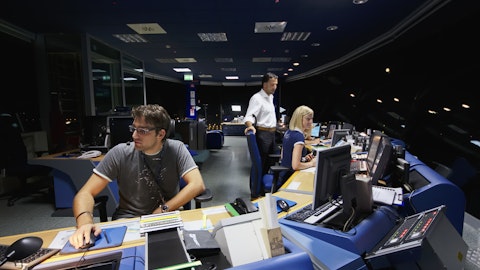Ciena Corporation (NYSE:CIEN) Q1 2023 Earnings Call Transcript March 6, 2023
Operator: Good day, and welcome to the Ciena’s Fiscal First Quarter 2023 Financial Results Conference Call. Please note this event is being recorded. I would now like to turn the conference over to Greg Lampf, Vice President of Investor Relations. Please go ahead.
Gregg Lampf: Thank you, Jason. Good morning, and welcome to Ciena’s 2023 fiscal first quarter results conference call. On the call today is Gary Smith, President and CEO; and Jim Moylan, CFO. Scott McFeely, our Senior Vice President of Global Products and Services, is also with us for Q&A. As OFC begins today, our team today is taking calls from the different locations. We ask for your patience during Q&A as we coordinate our responses please. In addition to this call and the press release, we have posted to the Investors section of our website an accompanying investor presentation that reflects this discussion as well as certain highlighted items from the quarter. Our comments today speak to our recent performance, our views on current market dynamics and drivers of our business as well as a discussion of our financial outlook.
Today’s discussion includes certain adjusted or non-GAAP measures of Ciena’s results of operations. A reconciliation of these non-GAAP measures to our GAAP results is included in today’s press release. Before turning the call over to Gary, I’ll remind you that during this call, we’ll be making certain forward-looking statements. Such statements, including our quarterly and annual guidance and our long-term financial outlook, discussion of market opportunities and strategy, commentary about our impacts of supply chain results on our business and results are based on current expectations, forecasts and assumptions regarding the company and its markets which include risks and uncertainties that could cause actual results to differ materially from the statements discussed today.
Assumptions relating to our outlook, which mentioned on this call are included in the investor presentation that will be posted shortly after, are an important part of such forward-looking statements, and we encourage you to consider them. Our forward-looking statements should also be viewed in the context of the risk factors detailed in our most recent 10-K filing and in our upcoming 10-Q filing, which is required to be filed with the SEC by March 9, and we expect to file by that date. Ciena assumes no obligation to update the information discussed in this conference call, whether as a result of new information, future events or otherwise. As always, we will allow for as much Q&A as possible today, though we ask that you limit yourselves to one question and one follow-up, please.
As a reminder, we’ll be hosting investor meetings with the sell side at OFC tomorrow and Wednesday. And we look forward to seeing many of you there. With that, I’ll turn the call over to Gary.
Gary Smith: Thanks, Gregg, and good morning, everyone. Today, we reported outstanding fiscal first quarter results including higher-than-expected quarterly revenue of $1.06 billion and adjusted gross margin of 43.7%. And in fact, Q1 was our largest revenue quarter ever, up 25% year-over-year. We also reported very strong profitability metrics, with quarterly adjusted operating margin of 12.6% and an adjusted EPS of $0.64. These results are a strong demonstration of our market leadership and continued demand for our market-leading technology across our complete portfolio. While supply chain has not completely recovered, and there is still some volatility in component deliveries, we are encouraged by the component availability in Q1 and our related strong shipment performance.
This is both, I think, a proof point of our mitigation efforts and a positive indicator of our expectation for continued gradual improvements in the supply environment as we move through the year. We are very pleased with this progress as we continue to work hard to fulfill our customers’ network capacity needs. With this strong momentum, we remain confident in our ability to grow faster than the market in both the short and long term and of course, take market share. This confidence is underpinned by three fundamental beliefs. First, the positive overall demand environment and the strength of our customer relationships. Second, the market-leading strength of our portfolio to best service customer demand. And lastly, the visibility, particularly provided by our backlog.
And with respect to demand, we remain positive about the fundamental drivers, including 5G, cloud, AI and automation and continue to believe that they are very durable over the long term. Indeed, these drivers require network operators to increase capacity, reduce latency and optimize power consumption while also intelligently converging technologies. These are critical elements across the core metro and increasingly edge network segments. And our customers know that they must continue investing in key parts of their networks to address these areas of their business in order to remain competitive. And there are clear signs, including our Q1 order book that point to be happening. Service these demand dynamics, we continue to leverage the strength of our business model and our investment capacity to remain at the forefront of innovation across our portfolio.
And our leading technology and strategic focus on addressable market expansions are closely aligned with our customers’ investment priorities. And in fact, you probably saw we just announced the sixth generation of our WaveLogic technology, which will once again set a new standard in coherent optics, where we have led the market for generations of this technology. WaveLogic 6 will be the first to support up to 1.6 terabits single-carrier wavelengths, 800 gig across the long these links and footprint optimized 800-gig pluggables that yet again, will have the lowest energy consumption. Our newest generation modem technology will be supported across a range of our optical and routing and switching platforms and will also be made available for use in third-party solutions.

Photo by Austin Distel on Unsplash
These breakthrough innovations in WaveLogic 6 are made possible through our unique expertise in coherent DSP and high-bandwidth electro optics, leveraging state-of-the-art 3-nanometer silicon technology. And in metro and edge, we continue to invest in market expansion and further solidify our role as the disruptive challenger in this space with a very compelling value proposition. These investments are positioning us to both pursue new opportunities and leverage our position with current customers to address use cases deeper in the network. And since we last spoke to you in December, we closed the acquisition of Tibit Communications, which further strengthens our solution in broadband access. Benefiting now from our vertical integration and a modern open architectural approach, we believe we are very well positioned to attack this rapidly growing market that is the focus of private and public investment across multiple regions.
These portfolio investments will be supported by similar efforts on software and services designed to enable customers to realize additional benefits of network automation, and execute on their network transformation strategies. And lastly, let me pick up on this point of we have a very strong visibility given our backlog. As a reminder, going into 2020, we had accumulated a multitude of new design wins and WaveLogic 5 Extreme was only just beginning initial commercial deployments at that time. Now given the dynamics of COVID and supply chain conditions, those wins only started to translate into orders during the last several quarters. As a result of these wins and industry dynamics during this period, our backlog grew from $1.2 billion at the end of fiscal 2020 to $4.2 billion as we entered fiscal 2023.
With that, it is clear that in recent periods, our backlog has far exceeded historical levels. In Q1, our backlog came down slightly because we significantly outperformed our revenue expectations. And of course, this is good news on a variety of fronts. First and most importantly, it means that we are delivering more product to our customers. Second, it’s an indicator that the supply chain challenges are improving. And lastly, our market share gains are becoming evident as we convert this backlog to revenue. And while we expect ebbs and flows with orders given the supply chain dynamics, as we move through ’23, orders for the year are off to a pretty good start. And even with these expected fluctuations, we expect to finish the year with backlog that is higher than our historical levels, albeit down from the extraordinary level we had at the beginning of the year.
Moving to additional highlights from the quarter that I think speak to our efforts to meet customer demand. In optical, WaveLogic 5 Extreme continues to be the world’s most widely deployed 800 gig coherent technology, including 13 new customers in Q1, bringing our total customer count to 214. And Q1 was our biggest modem shipment quarter ever overall, including for WaveLogic 5e, for which we’ve now surpassed 60,000 modems shipped to date. It was also, of course, our strongest WaveLogic 5e modem production quarter ever as well. In Routing and Switching, with a focus on next-gen metro and edge, we continue to press down our efforts and to expand our addressable market and gain market share. Overall, quarterly revenue for our Routing and Switching segment increased 39% year-over-year and Q1 was, of course, also a record shipment quarter for these platforms.
And within this portfolio, we secured new wins in Q1 for our Broadband Access Solution, which includes the recently acquired technology from both Benu Networks and Tibit Communications. Shifting to customer segments and regions in the quarter, non-telco revenue was 40% of total sales in Q1. This reflects a strong performance with web-scale, which included a 10% customer in the quarter. Direct web-scale was 24% of total revenue in the quarter and increased 47% year-over-year. We remain very positive about the year with this group of customers. In fact, in FY ’23, we expect record revenue in web-scale and growth well above the corporate average. As we continue to focus on driving growth outside the U.S., Q1 revenue in the APAC region was up 41% year-over-year.
This was largely driven by revenue growth in India, which was up 150% year-over-year in Q1 to $64 million, reflecting the strong demand environment in that market. And finally, we are placing an intense focus on customer experience; specifically, the combination of our investment in inventory over the last 12 months and a ramp-up of our service team’s readiness to deploy for our customers, as fast as possible as we ship product. In summary, we have great momentum in the market today, supported by robust fundamental demand drivers, a market-leading set of technologies and platforms and strong visibility with our backlog. And with that, we are confident that we will deliver outsized year-over-year revenue growth in FY ’23 and that we remain on track to achieve the 3-year revenue CAGR outlook we previously provided.
With that, I will now turn over to Jim to speak more on those items as well as to provide additional detail on the Q1 financial results. Jim?
James Moylan: Thanks, Gary. Good morning, everyone, and an especially good very early morning to those on the West Coast at OFC. As Gary mentioned, we had a tremendous performance in Q1 that demonstrates our strong position as the market leader. Total revenue was $1.06 billion, higher than expected. We shipped more product than expected due to improvements in vendor component deliveries, particularly toward the end of the quarter. Adjusted gross margin was strong at 43.7% reflecting a favorable product mix and specifically a high volume of modems. Modems carry higher gross margins than average, and they made up a significant percentage of the late quarter shipments. Q1 adjusted operating expense was $329 million, reflecting our investments in TAM expansion and it included OpEx from the acquisitions of Benu and Tibit.
With respect to profitability measures, in Q1, we delivered strong results, including adjusted operating margin of 12.6%, adjusted net income of $95.6 million and adjusted EPS of $0.64 per share. In addition, we used cash from operations in the quarter, primarily related to increases in inventory and accounts receivable. Our inventory levels reflect our continued investment in components and other raw materials to manage the impact of supply chain volatility on our customers. As supply conditions gradually improve, we expect inventory levels to come down as we move through fiscal 2023, but to remain elevated relative to historical levels. We do believe that inventory will be lower in Q4 of this year than in Q4 of 2022. And finally, adjusted EBITDA in Q1 was $155.1 million.
Benefiting from our successful term loan transaction in Q1, we ended the quarter with approximately $1.2 billion in cash and investments. And just as a reminder, during Q1, we acquired Benu and Tibit for an aggregate price of approximately $292 million. With our strong balance sheet, we intend to return capital to stockholders, including our continued expectation for the repurchase of approximately $250 million in shares during this fiscal year. Turning now to guidance. I want to be clear that the updated outlook I’m about to provide reflects the same set of key assumptions that we discussed last quarter and which are also in our earnings presentation, including those related to supply chain conditions. This latter point is particularly important in a still uncertain supply chain environment.
We believe that gradually improving supply conditions of the type we saw in Q1 will begin to allow for greater deployments of our accumulated design wins as well as for new business from customers pursuing best-in-class technology across our portfolio. Accordingly, in Q2, we expect to deliver revenue in a range of $1.035 billion to $1.115 billion; adjusted gross margin in the low 40% range; and adjusted operating expense in Q2 of roughly $335 million. With respect to the fiscal year, we expect to achieve strong share gains as already reflected in our significant revenue over-performance in Q1 and our expectations for Q2. Therefore, we now expect to achieve fiscal year ’23 revenue growth in a range of 20% to 22%, up from 16% to 18%. For adjusted gross margin, we continue to believe that our gross margin for fiscal ’23 will be in a range of 42% to 44%.
This reflects our expectation for a greater proportion of line systems in our product mix over the next few quarters. And for adjusted operating expense, we expect to average approximately $335 million — $330 million per quarter for fiscal year 2023. This reflects our intent to continue investing strategically in our future, primarily targeting opportunities for TAM expansion in next-gen metro and edge. This latter area is very rapidly growing, and we see potential to gain share with our best-in-class offerings. It’s clear from the quarterly results we reported today, as well as our outlook for Q2 and fiscal year 2023 that we are performing extremely well. We have never felt better about our position in our business. The combination of robust demand drivers are market-leading technologies and platforms and expanding addressable market and strong visibility with our sizable backlog gives us high confidence in market share gains over the next few years.
Jason, we will now take questions from the sell-side analysts.
See also 15 Countries with Highest Inflation Rates and 20 Most Important Companies in the World.
Q&A Session
Follow Ciena Corp (NYSE:CIEN)
Follow Ciena Corp (NYSE:CIEN)
Operator: Our first question comes from George Notter from Jefferies.
George Notter: I guess I wanted to ask a bit about backlog. You said it was down slightly. Could you just give us a precise number? I think you said it was $4.2 billion last quarter, but just was curious on the update. And then also wondering if you’re seeing any cancellations on that backlog, any more detail you could give us there? And then just also product lead times. Obviously, lead times have been extended in a lot of areas of the business. I’m just curious what the update is there?
Gary Smith: Let me take that, George. We don’t normally give sort of precise sort of backlog, but given the environment to it, I would say this, if we’ve had finished at the midpoint of our guide, then we would basically have replenished all of our backlog. So we ate through some of our backlog principally because our revenue was $100 million over our expectation for the quarter. So we still have a incredibly healthy backlog that we expect to come down during the year. We do not think this level of backlog is sustainable or frankly, desirable. Customers want equipment. They don’t want it sitting on our — don’t want it sitting on our backlog. And that really bleeds into the second part of the question on the sort of cancellation. We’re not seeing any change in update to that. It’s a very small and minor and just normal run-of-the-mill type cancellations. So we’re very confident about the integrity of the backlog. What was the third question, George?
George Notter: I guess it was just about product lead times. I know they’ve been extended for some time now. I’m just wondering if you’re able to make a dent on this.
Scott McFeely: Yes, George, it’s Scott, product lead times have improved as we’ve just shipped more products and have sort of built a bigger ship going forward. They will continue to improve throughout the year, although I don’t think we will get them back to historical levels in this fiscal year. And I’m not sure what the new norm will be, but they will be significantly improved as we go throughout the year.
Operator: Our next question comes from Tal Liani from Bank of America.
Tal Liani: I have a follow-up on the previous question, and I have another question on cloud. So the first one is, when I look at the results of all the companies in the space and I’m general networking, let’s say, it’s all the same, meaning very strong revenues. Margins are going up because of higher revenues, but the backlog is coming down. And the question is — and I’m asking on the other side. I mean, George asked you about the backlog, I’ll ask about the environment. The question is, how much — you sound very confident as well as Cisco sounded confident. How much of this strength is really a backlog flush and historical orders with the risk that this will end when the backlog going down to normal levels? And how much of it is basically a strong environment that really needs a strong network, underlying network.
So if you can talk about the environment, the orders, the kind of projects and customers, et cetera. So that’s first question. And I’ll ask both questions together because they are linked. The second question is about cloud. Another thing that we have seen with Arista, for example, is that cloud is strong. And for you, if you don’t mind to repeat the numbers, but I think cloud was up 47%. And the question is how much risk is there in the concentration of maybe one big customer, one big quarter, with their budgets coming down, what’s the risk here that cloud will slow down throughout the year?




